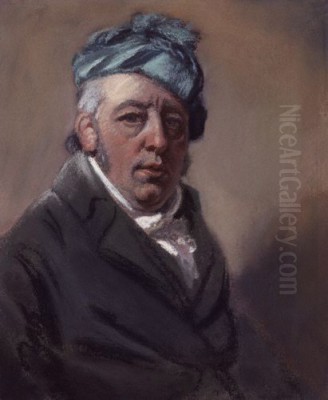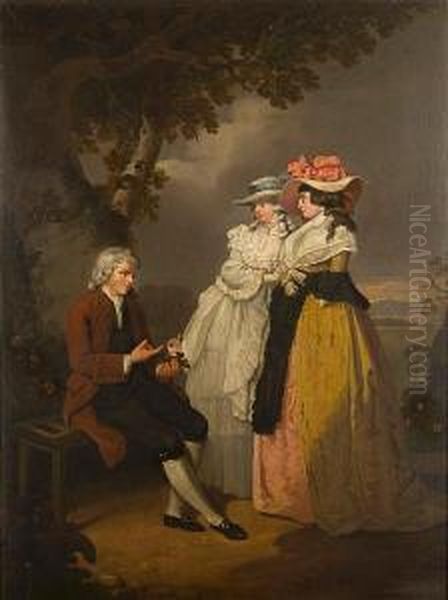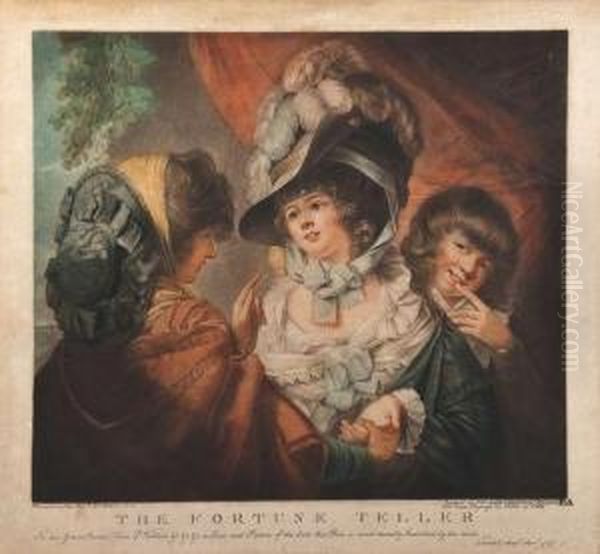
John Raphael Smith (1752–1812) stands as one of the most accomplished and influential figures in British art during the late 18th and early 19th centuries. A master of the mezzotint technique, a skilled stipple engraver, and a celebrated pastel portraitist, Smith's multifaceted career left an indelible mark on the artistic landscape of his time. His ability to capture the essence of contemporary life, reproduce the works of leading painters with remarkable fidelity, and create original compositions of enduring charm and social commentary secured his place in art history. This exploration delves into his life, his artistic evolution, his significant works, his network of contemporaries, and his lasting legacy.
Early Life and Artistic Awakening
Born in Derby, England, in 1752, John Raphael Smith was the son of Thomas Smith of Derby (c.1715–1767), a respected landscape painter. This familial connection to the arts undoubtedly provided an early exposure to visual culture and artistic practice, though John Raphael Smith is largely considered to have been self-taught in the specific skills he would later master. His father, known for his picturesque views of the Derbyshire landscape and country estates, likely instilled in his son an appreciation for observation and draughtsmanship.
Around 1767, following his father's death, the young Smith moved to London, the burgeoning center of the British art world and a city teeming with opportunities for aspiring artists and craftsmen. Initially, he is said to have worked as a shopman, possibly for a linen draper. However, his artistic inclinations soon led him towards printmaking. London at this time was experiencing a golden age of engraving, with a robust market for prints that disseminated art, fashion, and social satire to a wide audience. Smith was drawn to this vibrant scene, recognizing the potential of printmaking as both an artistic medium and a commercial enterprise.
The Ascendancy of a Mezzotint Master

John Raphael Smith's primary claim to fame in his early career was his exceptional skill in mezzotint engraving. Mezzotint, a tonal intaglio printmaking process, allows for the creation of rich, velvety blacks and subtle gradations of tone, making it particularly well-suited for reproducing the painterly qualities of oil portraits and genre scenes. Smith rapidly mastered this demanding technique, demonstrating a remarkable ability to translate the textures, light, and shadow of original paintings into monochrome prints.
His earliest recorded prints date from the late 1760s and early 1770s. One of his first notable successes was "The Public Ledger," a print that gained considerable popularity. Another significant early work was "Edwin the Minstrel," based on a portrait of Thomas Hardy. These pieces showcased his burgeoning talent and his eye for subjects that resonated with the public. His mezzotints were praised for their delicacy, their lively characterisation, and the richness of their tonal range. He possessed an innate understanding of how to use the scraper and burnisher to coax an extraordinary array of effects from the rocked copper plate.
Smith's technical proficiency was matched by his entrepreneurial spirit. He not only engraved plates but also published many of his own prints, as well as those by other artists, from his premises in London. This dual role as artist and publisher gave him considerable control over his output and a direct connection to the market.
Engraver to the Great Painters
A significant portion of John Raphael Smith's engraving work involved the reproduction of paintings by the leading artists of his day. This practice was crucial in the 18th century for disseminating an artist's work to a wider audience, enhancing their reputation, and providing an additional source of income for both painter and engraver. Smith became one of the most sought-after reproductive engravers, particularly for his interpretations of portraits.
He produced a remarkable number of plates after Sir Joshua Reynolds, the first President of the Royal Academy and the dominant portrait painter of the era. Smith's mezzotints after Reynolds, such as his renditions of society beauties and distinguished gentlemen, captured the elegance, psychological depth, and painterly bravura of Reynolds's originals. These prints were highly prized and played a vital role in cementing Reynolds's fame. Among these are celebrated prints like "Mrs. Carnac" and "Lieutenant-Colonel Banastre Tarleton."

Smith also engraved works by other prominent contemporaries, including Thomas Gainsborough, George Romney, Joseph Wright of Derby, Henry Fuseli, Angelica Kauffman, and Benjamin West. His print of Joseph Wright of Derby's "The Indian Widow" (1785) is a powerful example of his ability to convey dramatic intensity. Similarly, his engravings after George Romney's graceful portraits helped to popularize that artist's distinctive style. His collaboration with George Morland was particularly fruitful, with Smith engraving many of Morland's popular rustic genre scenes, such as "The Slave Trade" (1791), which, while based on Morland's painting, also reflected Smith's own engagement with contemporary social issues.
His skill was such that he was appointed Mezzotint Engraver to the Prince of Wales (later King George IV), a prestigious title that underscored his preeminence in the field. This royal patronage further enhanced his reputation and brought him numerous commissions.
Original Compositions and Social Commentary
While renowned for his reproductive engravings, John Raphael Smith was also a talented original artist who created his own designs for prints. These often took the form of genre scenes, depicting everyday life, sentimental subjects, or light-hearted social satire. These works reveal his keen observation of human nature and the manners and fashions of his time.
"The Circulating Library" (1781) is a charming example, offering a glimpse into the social world of the lending library, a popular institution in 18th-century England. Works like "The Mirror—Serena and Flirtilla" (1782) and "Black, Brown, and Fair" (1785) often explored themes of femininity, courtship, and societal expectations, sometimes with a gently satirical edge. He produced a series of prints known as "Laetitia," or "The Progress of a Woman of Pleasure," which, while echoing the moralizing narratives of William Hogarth, were rendered with a softer, more sentimental touch.
Smith also employed stipple engraving, a technique that uses dots and short flicks to build up tones, often favored for its delicate effects, particularly in rendering flesh tones and subtle expressions. He used this technique for many of his more sentimental or decorative subjects. His versatility across different engraving methods allowed him to choose the technique best suited to the subject matter and the desired aesthetic effect.
The Transition to Pastel Portraiture
By the early 1800s, the market for mezzotint engravings began to face challenges from newer, cheaper printmaking techniques and shifting public tastes. Around 1802, John Raphael Smith largely abandoned his engraving business and increasingly turned his attention to pastel portraiture. This was not an entirely new departure, as he had been drawing in pastels for some time, but it now became his primary artistic focus.
Pastel, with its vibrant colours and direct application, allowed for a different kind of artistic expression than the monochrome world of mezzotint. Smith quickly established a reputation as a skilled and prolific pastelist. His pastel portraits were typically small in scale, intimate, and executed with a remarkable speed and facility. He was said to be capable of completing several portraits in a single day, and contemporary accounts suggest he could have as many as forty sitters in a week.
His subjects included notable figures of the day, such as Charles James Fox, but he also produced numerous portraits of less famous individuals, capturing their likenesses with a characteristic freshness and vivacity. His pastel work, like his prints, often displayed a keen understanding of character. Notable examples include portraits like "Lord Fox" and "Honora Power." His style in pastel was direct and unpretentious, focusing on capturing a lively and accurate resemblance. The colours are often bright and appealing, and the handling confident.
Artistic Relationships: Teacher, Pupils, and Collaborators
John Raphael Smith's artistic network was extensive. His primary, albeit informal, teacher was his father, Thomas Smith of Derby. While he didn't run a formal academy, Smith's studio became a training ground for several artists who would go on to achieve distinction in their own right, particularly in the field of engraving.
Among his most notable pupils were William Ward and James Ward. William Ward (1766–1826) became an accomplished mezzotint engraver, eventually being appointed Engraver to the Duke of York and an Associate of the Royal Academy. He also married Smith's sister, Maria, further cementing the artistic connection. James Ward (1769–1859), William's younger brother, also studied with Smith before developing a highly successful career as a painter of animals and romantic landscapes, becoming a full Royal Academician.
Another significant pupil was Charles Howard Hodges (1764–1837), who became a successful portrait painter and mezzotint engraver, later moving to the Netherlands where he enjoyed considerable success. Peter De Wint, the celebrated watercolourist, also spent some time with Smith, though primarily learning about the print trade rather than engraving itself. The influence Smith wielded through these pupils helped to perpetuate the high standards of British mezzotint engraving into the next generation.
His collaborations with painters were also crucial. His relationship with George Morland was particularly close and productive. Smith engraved and published a large number of Morland's works, contributing significantly to Morland's widespread popularity. This symbiotic relationship benefited both artists, with Morland providing appealing subjects and Smith translating them into highly saleable prints. Other painters whose work he frequently engraved, like Reynolds and Romney, also formed part of this collaborative ecosystem that defined the 18th-century London art world. He was also a contemporary of other notable engravers such as Valentine Green and Richard Earlom, who were also pushing the boundaries of mezzotint.
Notable Works: A Diverse Portfolio
John Raphael Smith's oeuvre is vast and diverse, encompassing reproductive engravings, original print compositions, and pastel portraits. Some of his most representative and celebrated works include:
"The Public Ledger" (c. 1770s): An early success that helped establish his reputation as an engraver.
"Edwin the Minstrel" (after Thomas Hardy): Another popular early print showcasing his skill in capturing character.
"Mercury inventing the Lyre" (1775): An original composition demonstrating his classical interests and draughtsmanship.
"The Watercress Girl" (after Johann Zoffany, 1780): A fine example of his reproductive work, capturing the charm of Zoffany's genre painting.
"The Circulating Library" (1781): An original genre scene offering a witty commentary on social life.
"Mrs. Carnac" (after Sir Joshua Reynolds, 1778): A masterful mezzotint that conveys the grandeur and elegance of Reynolds's society portraiture.
"Lieutenant-Colonel Banastre Tarleton" (after Sir Joshua Reynolds, 1782): A dynamic and powerful print capturing the military hero in a dramatic pose.
"The Indian Widow" (after Joseph Wright of Derby, 1785): A dramatic and atmospheric rendering of Wright's painting.
"The Moralist" (after his own design, featuring a portrait of his daughter, Emma Smith, 1787): A charming example of his original compositions, often imbued with sentimental appeal.
"The Slave Trade" (after George Morland, 1791): A significant print addressing a pressing social issue of the time, demonstrating the power of prints to engage in public discourse.
"The Most Revd Richd Robinson, D:D: Archbishop Of Armagh Primate And Metropolitan Of All Ireland" (1811): A later work, possibly a pastel or an engraving after a pastel, showing his continued activity in portraiture.
Pastel Portraits (various, c. 1802-1812): His numerous pastel portraits, such as those of "Lord Fox" and "Honora Power," are characterized by their directness, vibrant color, and ability to capture a sitter's personality efficiently.
His works were regularly exhibited at the Society of Artists and the Royal Academy of Arts in London, further solidifying his standing within the artistic community.
Style, Technique, and Lasting Impact
John Raphael Smith's artistic style is characterized by its technical brilliance, its versatility, and its keen engagement with the subjects and sensibilities of his era. In mezzotint, he achieved a remarkable richness of tone, from deep, velvety blacks to the most delicate highlights. His handling of the medium was fluid and expressive, allowing him to capture a wide range of textures and atmospheric effects. He was particularly adept at rendering the sheen of fabrics, the softness of flesh, and the sparkle of an eye.
His original compositions often displayed a gentle humour and a sympathetic observation of human nature. While sometimes sentimental, they avoided excessive mawkishness, often incorporating elements of social observation or mild satire. His series prints, like "Laetitia," show an interest in narrative and moral themes, a tradition well-established in British art by figures like Hogarth.
In his pastel portraits, Smith's style was more direct and immediate. He worked quickly, capturing essential likenesses with bold strokes and fresh, clear colours. These portraits have an unpretentious charm and provide a valuable record of the faces of his time.
John Raphael Smith's historical impact is significant. As a reproductive engraver, he played a crucial role in popularizing the work of Britain's leading painters, making art accessible to a broader public and contributing to the growth of a national school of art. His own original prints contributed to the flourishing genre of social observation and sentimental narrative that was so popular in the late 18th century.
His influence extended through his pupils, who carried forward the traditions of British mezzotint engraving. The sheer volume of his output – nearly 400 documented prints – attests to his industry and his central position in the London print market. His works are now held in major museum collections worldwide, including the British Museum, the Victoria and Albert Museum, the National Portrait Gallery in London, and numerous institutions in the United States and elsewhere.
Later Years and Enduring Legacy
John Raphael Smith continued to work actively as a pastel portraitist in his later years. Despite his considerable success and prolific output, contemporary accounts suggest he lived a somewhat prodigal life and did not accumulate great wealth. He passed away in Doncaster on March 2, 1812.
His legacy, however, is secure. He is remembered as one of the foremost British engravers of his generation, a master of mezzotint whose prints are still admired for their technical virtuosity and artistic sensitivity. His pastel portraits offer a vibrant and immediate connection to the personalities of his time. Through both his reproductive and original works, John Raphael Smith provided a rich visual commentary on late Georgian England, capturing its celebrities, its social customs, its fashions, and its sentiments. He remains a key figure for understanding the art world of 18th-century Britain and the vital role that printmaking played within it. His ability to excel in multiple mediums, from the demanding intaglio processes to the directness of pastel, marks him as an artist of exceptional talent and adaptability.